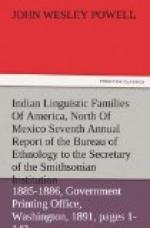> Natchez, Bancroft, Hist. U.S., 248, 1840. Gallatin in Trans. Am. Eth. Soc., II, pt. 1, xcix, 77, 1848 (Natchez only). Latham, Nat. Hist. Man, 340, 1850 (tends to include Taensas, Pascagoulas, Colapissas, Biluxi in same family). Gallatin in Schoolcraft, Ind. Tribes, III, 401, 1853 (Natchez only). Keane, App. Stanford’s Comp. (Cent, and So. Am.), 460, 473, 1878 (suggests that it may include the Utchees).
> Naktche, Gatschet, Creek Mig. Legend,
I, 34, 1884. Gatschet in
Science, 414, April 29, 1887.
> Taensa, Gatschet in The Nation, 383,
May 4, 1882. Gatschet in Am.
Antiq., IV, 238, 1882. Gatschet,
Creek Mig. Legend, I, 33, 1884.
Gatschet in Science, 414, April 29, 1887
(Taensas only).
The Na’htchi, according to Gallatin, a residue of the well-known nation of that name, came from the banks of the Mississippi, and joined the Creek less than one hundred years ago.[71] The seashore from Mobile to the Mississippi was then inhabited by several small tribes, of which the Na’htchi was the principal.
[Footnote 71: Trans. Am. Antiq. Soc., 1836, vol. 2, p. 95.]
Before 1730 the tribe lived in the vicinity of Natchez, Miss., along St. Catherine Creek. After their dispersion by the French in 1730 most of the remainder joined the Chicasa and afterwards the Upper Creek. They are now in Creek and Cherokee Nations, Indian Territory.
The linguistic relations of the language spoken by the Taensa tribe have long been in doubt, and it is probable that they will ever remain so. As no vocabulary or text of this language was known to be in existence, the “Grammaire et vocabulaire de la langue Taensa, avec textes traduits et commentes par J.-D. Haumonte, Parisot, L. Adam,” published in Paris in 1882, was received by American linguistic students with peculiar interest. Upon the strength of the linguistic material embodied in the above Mr. Gatschet (loc. cit.) was led to affirm the complete linguistic isolation of the language.
Grave doubts of the authenticity of the grammar and vocabulary have, however, more recently been brought forward.[72] The text contains internal evidences of the fraudulent character, if not of the whole, at least of a large part of the material. So palpable and gross are these that until the character of the whole can better be understood by the inspection of the original manuscript, alleged to be in Spanish, by a competent expert it will be far safer to reject both the vocabulary and grammar. By so doing we are left without any linguistic evidence whatever of the relations of the Taensa language.
[Footnote 72: D. G. Brinton
in Am. Antiquarian, March, 1885, pp.
109-114.]




